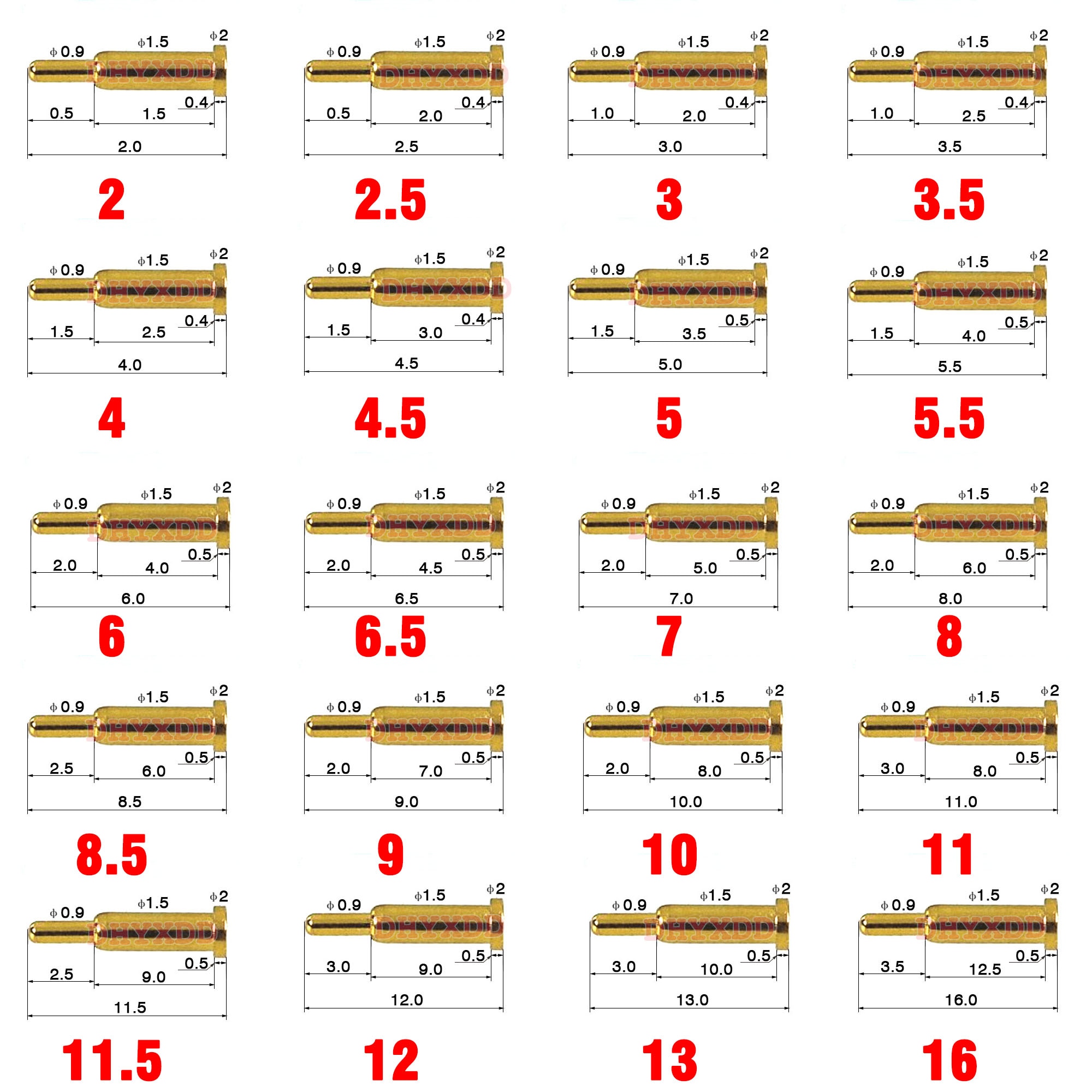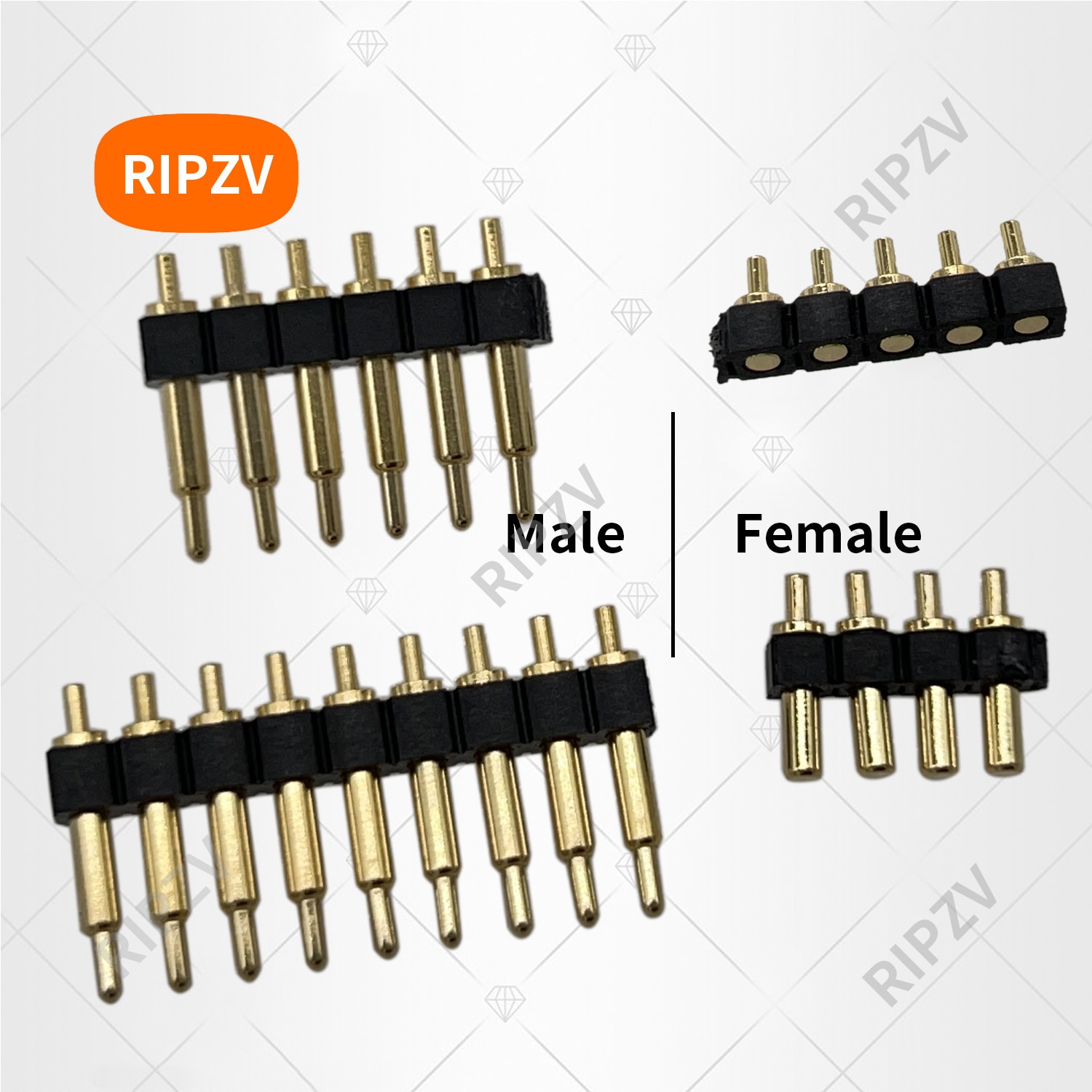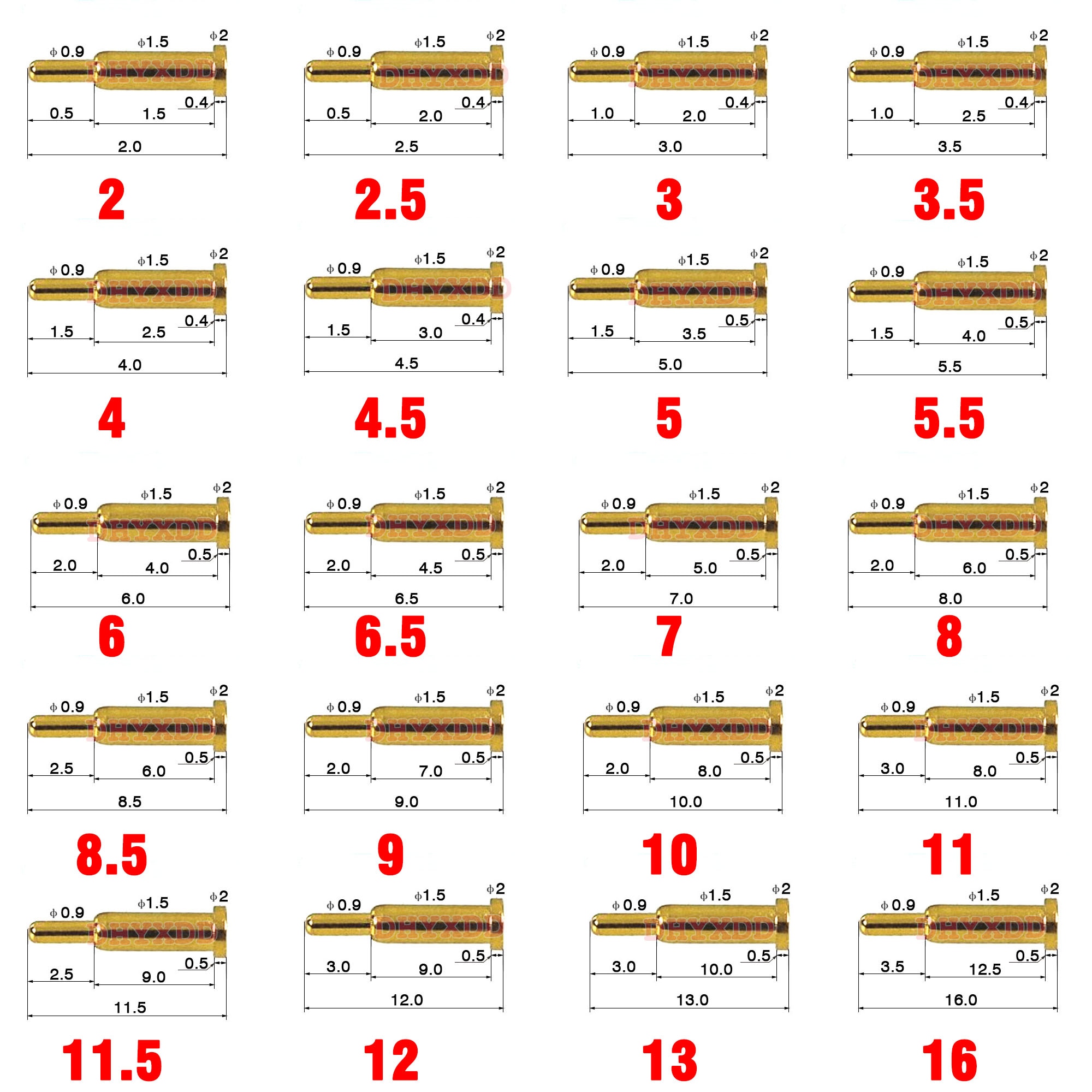Glossary of Terms
Detailed information about terms and definitions on our website:
Aurun
Aurun is a gold-alloy plating that was specifically
developed for test probes and has a very good chemical resistance hardness
300-350 HV. This plating is best used for aggressive tip styles for testing
unwashed print circuit boards.
Barrel / Body
The barrel / body accommodates the plunger and spring. The
measurement signal flows via the barrel to the receptacle.
Beryllium
Beryllium is a chemical element with
symbol Be and atomic number 4. It is a relatively rare
element in the universe, usually occurring as a product of the spallation of
larger atomic nuclei that have collided with cosmic rays. Within the cores
of stars beryllium is depleted as it is fused and creates larger elements. It
is a divalent element which occurs naturally only in combination with
other elements in minerals. Notable gemstones which contain beryllium
include beryl (aquamarine, emerald) and chrysoberyl. As a
free element it is a steel-gray, strong, lightweight and
brittle alkaline earth metal.
Beryllium Copper
Beryllium copper (BeCu),
also known as copper beryllium (CuBe), beryllium bronze and spring
copper, is a copper alloywith 0.5—3% beryllium and
sometimes other elements. Beryllium copper combines high strength with
non-magnetic and non-sparking qualities. It has excellent metalworking,
forming and machining properties. It has many specialized applications in tools
for hazardous environments, musical instruments, precision measurement devices,
bullets, and aerospace.
Brass
Brass is a metal alloy made of copper and zinc;
the proportions of zinc and copper can be varied to create a range of brasses
with varying properties. It is a substitutional alloy: atoms of the
two constituents may replace each other within the same crystal structure.
Copper
Copper is a chemical element with
symbol Cu (from Latin: cuprum) and atomic number 29.
It is a soft, malleable, and ductile metal with very high thermal and electrical
conductivity. A freshly exposed surface of pure copper has a reddish-orange
color. Copper is used as a conductor of heat and electricity, as a building
material, and as a constituent of various metal alloys, such as sterling
silver used in jewelry, cupronickel used to make marine
hardware and coins, and constantan used in strain gauges and thermocouples for
temperature measurement.
Fine Pitch
Fine pitch is a classification of probes with a very small
center-to-center spacing, typically less than 1.27 mm (0.50 in). When deciding
to use a fine pitch probe in an application it must be deigned to be used with
a receptacle or not. If the test probe is used with a receptacle, then the test
probe is changed in the common way from above, without removing the electrical
connection. When a test probe is used without the receptacle the pitch can be
smaller. Using this method, the test probes are float mounted in a guide plate
and are then centered and secured by means of a mounting plate.
Frequency
Frequency is the number of occurrences of a repeating
event per unit time. It is also referred to as temporal frequency,
which emphasizes the contrast to spatial frequency and angular
frequency. The period is the duration of time of one cycle in
a repeating event, so the period is the reciprocal of the frequency. For
example, if a newborn baby’s heart beats at a frequency of 120 times a minute,
its period—the time interval between beats—is half a second (that is,
60 seconds divided by 120 beats). Frequency is an important parameter
used in science and engineering to specify the rate of oscillatory and vibratory phenomena,
such as mechanical vibrations, audio (sound) signals, radio
waves, and light.
Full Compression
The full compression of a test probe (also know as maximum
stroke) is the maximum length used to fully compress the test probe. If you exceed
this length of compression, there is a possibility of damaging the unit under
test or print circuit board.
Gold
Gold is a chemical element with symbol Au (from Latin: aurum)
and atomic number 79. In its purest form, it is a bright, slightly
reddish yellow, dense, soft, malleable, and ductile metal.
Chemically, gold is a transition metal and a group 11 element.
It is one of the least reactive chemical elements and is solid under standard
conditions. Gold often occurs in free elemental (native) form, as nuggets or
grains, in rocks, in veins, and in alluvial deposits. It occurs
in a solid solution series with the native element silver (as electrum)
and also naturally alloyed with copper and palladium.
Less commonly, it occurs in minerals as gold compounds, often with tellurium (gold
tellurides).
High Current Probe
High current test probes are used when in need of a large direct
signal through the probe. In a high current test probe, the plunger can be made
two different ways. One way is the plunger is made of two sections that are
deflected away from each other in the radial direction. This leads to the
enlargement of the contact zones. Another way is to have a continuous plunger.
This design provides a very constant and stable low resistance.
IP Rating
The IP
Code, International Protection Marking, IEC standard 60529, sometimes
interpreted as Ingress Protection Marking, classifies and rates the degree
of protection provided against intrusion (body parts such as hands and
fingers), dust, accidental contact, and water by mechanical casings
and electrical enclosures. It is published by the International
Electrotechnical Commission (IEC). The equivalent European standard is EN
60529. The standard aims to provide users more detailed information than vague
marketing terms such as waterproof. The digits (characteristic numerals)
indicate conformity with the conditions summarized in the tables below. Where
there is no data available to specify a protection rating with regard to one of
the criteria, the digit is replaced with the letter X. The digit 0 is
used where no protection is provided.
New Silver (NiAg)
New Silver and bronze are mainly used for receptacles and
the barrels / bodies of test probes. This material has a high tensile strength,
which is ideal for the long-term life of test probes. This material also acts
as a good elasticity of the crimps on the receptacles.
Nickel
Nickel is a chemical element with
symbol Ni and atomic number 28. It is a silvery-white
lustrous metal with a slight golden tinge. Nickel belongs to
the transition metals and is hard and ductile. Pure nickel, powdered to
maximize the reactive surface area, shows a significant chemical activity,
but larger pieces are slow to react with air under standard conditions because
an oxide layer forms on the surface and prevents further corrosion (passivation).
Even so, pure native nickel is found in Earth’s crust only in tiny
amounts, usually in ultramafic rocks, and in the interiors of
larger nickel–iron meteorites that were not exposed to oxygen when
outside Earth’s atmosphere.
Nickel Silver
Nickel silver is a copper alloy with nickel and
often zinc. The usual formulation is 60% copper, 20% nickel and 20% zinc. Nickel
silver is named for its silvery appearance, but it contains no elemental silver unless
plated. The name “German silver” refers to its development by
19th-century German metalworkers in imitation of the Chinese alloy known
as paktong (cupronickel). All modern, commercially important
nickel silvers (such as those standardized under ASTM B122) contain
significant amounts of zinc, and are sometimes considered a subset of brass.
Phosphor bronze
Phosphor bronze is an alloy of copper with
0.5–11% of tin and 0.01–0.35% phosphorus. The tin increases the
corrosion resistance and strength of the alloy. The phosphorus increases the
wear resistance and stiffness of the alloy.
Plunger
The plunger must provide the smallest amount of contact
resistance between the test probe and test point, to ensure that measurement
results are not distorted. The most common plunger materials are beryllium copper
and steel. There are two places for the plunger on the test probe. The top of
the plunger which is referred to as the contact and the bottom of the plunger
which is referred to as the terminal.
Pneumatic Probes
Pneumatic test probes are operated with compressed air.
Before activation, the plunger is at rest. When compressed air is applied, the
plunger shoots out contacting the test point. The spring inside the barrel retrieves
the plunger after releasing the compressed air.
Radio Frequency Probes
Radio frequency test probes are mainly used for measuring
high-frequency signals. These probes are used to contact RF-Plugs and Rf-Jacks.
Receptacle
The receptacle provides easy interchange of the test probe
during maintenance and service of the test fixture. The exchange can be carried
out fast and without any wiring work due to the crimp points that are on the
side of a receptacle.
Recommended Compression
The recommended compression on a test probe is the
recommended length of travel used when under compression. Using the recommended
compression on a test probe will ensure a longer lasting cycle life.
Rhodium
Rhodium is a chemical element with
symbol Rh and atomic number 45. It is a rare,
silvery-white, hard, and chemically inert transition metal. It is a
member of the platinum group. It has only one naturally occurring isotope, 103Rh.
Naturally occurring rhodium is usually found as the free metal, alloyed with
similar metals, and rarely as a chemical compound in minerals such as bowieite and rhodplumsite.
It is one of the rarest and most valuable precious metals.
RoHS
RoHS is designed to encourage
manufacturers to consider the impact of discarded electronics on the
environment, and has arguably been the first and main driver for change in the
industry. Member States of the EU have raised their own legislation to
meet, if not exceed, these directives, and other countries around the world are
also passing laws which reflect the intent of the RoHS Directive.
Rotating Probe
A rotating probe is used to ensure reliable contacting of
surfaces. Rotating probes have a rotating plunger, which digs itself into the
surface that it touches. The rotating movement of the plunger provides a
reliable breaking of the surface but will lead to more maintenance of the probe
due to higher levels of contamination.
Short Stroke Probes
Solderable Probes
Test probes can not only be used for test purposes in a
ICT/FCT application but can also be soldered directly into or onto print
circuit boards and electronic units. Using this method the test probe is used
without a receptacle.
Spring
The spring provides the necessary
contact pressure to the part being tested. Even after several hundred thousand
strokes it will keep the same pressure. The spring resides inside the
barrel/body of the test probe. The most common materials that the spring is
made of are beryllium copper, music wire, and stainless steel.
Steel
Steel is an alloy of iron and other
elements, primarily carbon. Because of its high tensile strength and
low cost, it is a major component in buildings, infrastructure, tools, ships, automobiles, machines,
appliances, and weapons.
Hardened Steel
The term hardened steel is often used for a medium
or high carbon steel that has been given heat treatment and then quenching
followed by tempering. The quenching results in the formation of
metastable martensite, the fraction of which is reduced to the desired
amount during tempering. This is the most common state for finished articles
such as tools and machine parts. In contrast, the same steel composition
in annealed state is softer, as required for forming and machining.
Switch Probe
WEEE
The Waste Electrical and Electronic Equipment Directive (WEEE
Directive) is the European Community Directive 2012/19/EU on waste
electrical and electronic equipment (WEEE) which, together with the RoHS
Directive 2002/95/EC, became European Law in February 2003. The
WEEE Directive set collection, recycling and recovery targets for all
types of electrical goods, with a minimum rate of 4 kilograms per head of
population per annum recovered for recycling by 2009. The RoHS Directive set
restrictions upon European manufacturers as to the material content of new
electronic equipment placed on the market.



 1pcs 3.0mm Pitch SMT DIP ...
1pcs 3.0mm Pitch SMT DIP ...  1pcs Male / Female Spring...
1pcs Male / Female Spring...  5Pcs Pogo Pin Connector P...
5Pcs Pogo Pin Connector P...